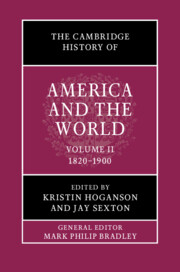Book contents
- The Cambridge History of America and the World
- The Cambridge History of America and the World
- The Cambridge History of America and the World
- Copyright page
- Contents
- Figures
- Maps
- Tables
- Contributors to Volume II
- General Introduction: What is America and the World?
- Introduction to Volume II
- Part I Building and Resisting US Empire
- Part II Imperial Structures
- Part III Americans and the World
- Part IV Americans in the World
- 23 The Changing Geography of Mobility, 1820–1940
- 24 The United States and the Greater Caribbean, 1763–1898
- 25 Borderlands and Border Crossings
- 26 The Liberal North Atlantic
- 27 “To Enter America from Africa and Africa from America” during the Nineteenth Century
- 28 Islamic World Encounters
- 29 The American Island Empire: US Expansionism in the Pacific and the Caribbean
- 30 Inter-Imperial Entanglements in the Age of Imperial Globalization
- Index
23 - The Changing Geography of Mobility, 1820–1940
from Part IV - Americans in the World
Published online by Cambridge University Press: 12 November 2021
- The Cambridge History of America and the World
- The Cambridge History of America and the World
- The Cambridge History of America and the World
- Copyright page
- Contents
- Figures
- Maps
- Tables
- Contributors to Volume II
- General Introduction: What is America and the World?
- Introduction to Volume II
- Part I Building and Resisting US Empire
- Part II Imperial Structures
- Part III Americans and the World
- Part IV Americans in the World
- 23 The Changing Geography of Mobility, 1820–1940
- 24 The United States and the Greater Caribbean, 1763–1898
- 25 Borderlands and Border Crossings
- 26 The Liberal North Atlantic
- 27 “To Enter America from Africa and Africa from America” during the Nineteenth Century
- 28 Islamic World Encounters
- 29 The American Island Empire: US Expansionism in the Pacific and the Caribbean
- 30 Inter-Imperial Entanglements in the Age of Imperial Globalization
- Index
Summary
Human mobility has its own periodization and its own geography. Neither tracks neatly to the more familiar periodization of American domestic politics or the geography of US international relations. While presidential elections, regional conflicts, and international treaties may influence mobility, their precise impact is not always predictable. Migration, developing in tandem with commerce, war, diplomacy, and the movement of capital investment, is always part of globalization, defined here as result of waxing and waning networks of diverse transnational circuits.
Viewing US immigration as one element in a history of globalization pushes attention away from a nineteenth century that began in 1800 and ended in 1899 toward a “long nineteenth century” that began and ended somewhat later. The United States first reported data on migrants in 1820; after 1840 immigration regularly surpassed one million entries per decade. (That means that in the 1840s each year of immigration added 0.6 percent to the American population.)
- Type
- Chapter
- Information
- The Cambridge History of America and the World , pp. 547 - 568Publisher: Cambridge University PressPrint publication year: 2022



